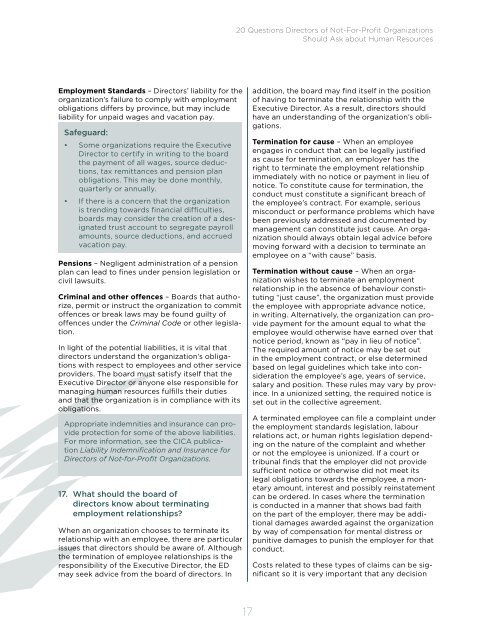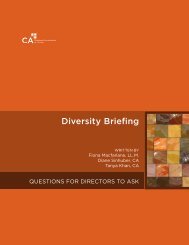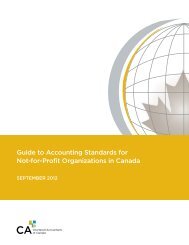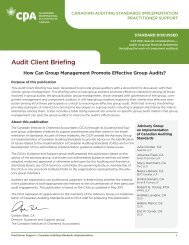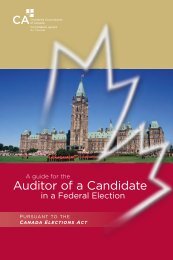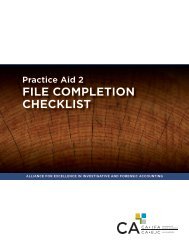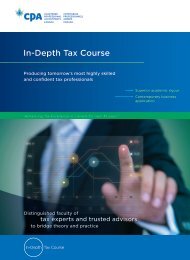2 0 questions - Canadian Institute of Chartered Accountants
2 0 questions - Canadian Institute of Chartered Accountants
2 0 questions - Canadian Institute of Chartered Accountants
You also want an ePaper? Increase the reach of your titles
YUMPU automatically turns print PDFs into web optimized ePapers that Google loves.
20 Questions Directors <strong>of</strong> Not-For-Pr<strong>of</strong>it OrganizationsShould Ask about Human ResourcesEmployment Standards – Directors’ liability for theorganization’s failure to comply with employmentobligations differs by province, but may includeliability for unpaid wages and vacation pay.Safeguard:• Some organizations require the ExecutiveDirector to certify in writing to the boardthe payment <strong>of</strong> all wages, source deductions,tax remittances and pension planobligations. This may be done monthly,quarterly or annually.• If there is a concern that the organizationis trending towards financial difficulties,boards may consider the creation <strong>of</strong> a designatedtrust account to segregate payrollamounts, source deductions, and accruedvacation pay.Pensions – Negligent administration <strong>of</strong> a pensionplan can lead to fines under pension legislation orcivil lawsuits.Criminal and other <strong>of</strong>fences – Boards that authorize,permit or instruct the organization to commit<strong>of</strong>fences or break laws may be found guilty <strong>of</strong><strong>of</strong>fences under the Criminal Code or other legislation.In light <strong>of</strong> the potential liabilities, it is vital thatdirectors understand the organization’s obligationswith respect to employees and other serviceproviders. The board must satisfy itself that theExecutive Director or anyone else responsible formanaging human resources fulfills their dutiesand that the organization is in compliance with itsobligations.Appropriate indemnities and insurance can provideprotection for some <strong>of</strong> the above liabilities.For more information, see the CICA publicationLiability Indemnification and Insurance forDirectors <strong>of</strong> Not-for-Pr<strong>of</strong>it Organizations.17. What should the board <strong>of</strong>directors know about terminatingemployment relationships?When an organization chooses to terminate itsrelationship with an employee, there are particularissues that directors should be aware <strong>of</strong>. Althoughthe termination <strong>of</strong> employee relationships is theresponsibility <strong>of</strong> the Executive Director, the EDmay seek advice from the board <strong>of</strong> directors. Inaddition, the board may find itself in the position<strong>of</strong> having to terminate the relationship with theExecutive Director. As a result, directors shouldhave an understanding <strong>of</strong> the organization’s obligations.Termination for cause – When an employeeengages in conduct that can be legally justifiedas cause for termination, an employer has theright to terminate the employment relationshipimmediately with no notice or payment in lieu <strong>of</strong>notice. To constitute cause for termination, theconduct must constitute a significant breach <strong>of</strong>the employee’s contract. For example, seriousmisconduct or performance problems which havebeen previously addressed and documented bymanagement can constitute just cause. An organizationshould always obtain legal advice beforemoving forward with a decision to terminate anemployee on a “with cause” basis.Termination without cause – When an organizationwishes to terminate an employmentrelationship in the absence <strong>of</strong> behaviour constituting“just cause”, the organization must providethe employee with appropriate advance notice,in writing. Alternatively, the organization can providepayment for the amount equal to what theemployee would otherwise have earned over thatnotice period, known as “pay in lieu <strong>of</strong> notice”.The required amount <strong>of</strong> notice may be set outin the employment contract, or else determinedbased on legal guidelines which take into considerationthe employee’s age, years <strong>of</strong> service,salary and position. These rules may vary by province.In a unionized setting, the required notice isset out in the collective agreement.A terminated employee can file a complaint underthe employment standards legislation, labourrelations act, or human rights legislation dependingon the nature <strong>of</strong> the complaint and whetheror not the employee is unionized. If a court ortribunal finds that the employer did not providesufficient notice or otherwise did not meet itslegal obligations towards the employee, a monetaryamount, interest and possibly reinstatementcan be ordered. In cases where the terminationis conducted in a manner that shows bad faithon the part <strong>of</strong> the employer, there may be additionaldamages awarded against the organizationby way <strong>of</strong> compensation for mental distress orpunitive damages to punish the employer for thatconduct.Costs related to these types <strong>of</strong> claims can be significantso it is very important that any decision17


